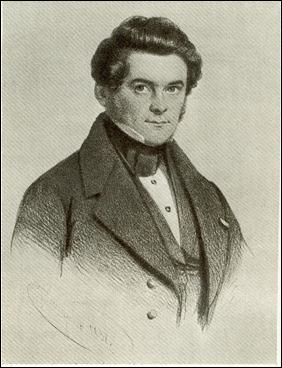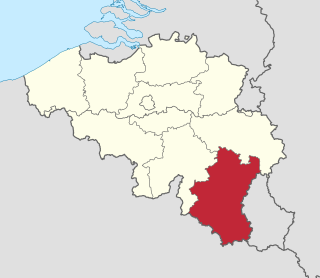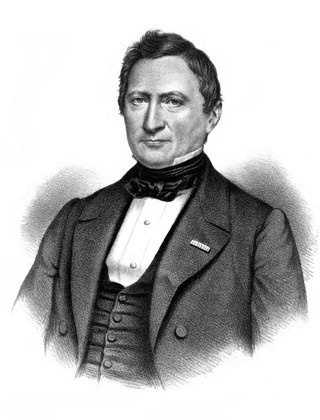
Forêts was a department of the French First Republic, and later the First French Empire, in present-day Belgium, Luxembourg, and Germany. Its name, meaning 'forests', comes from the Ardennes forests. It was formed on 24 October 1795, after the Austrian Netherlands had been annexed by France on 1 October. Before annexation, the territory was part of the Duchy of Luxembourg and small parts of the Duchy of Bouillon. Its capital was Luxembourg City.

There were three Partitions of Luxembourg between 1659 and 1839. Together, the three partitions reduced the territory of the Duchy of Luxembourg from 10,700 km2 (4,100 sq mi) to the present-day area of 2,586 km2 (998 sq mi) over a period of 240 years. The remainder forms parts of modern-day Belgium, France, and Germany.

Charles Gérard Emmanuel Metz was a Luxembourgish politician, journalist, and lawyer. He was a prominent pro-Belgian in the Belgian Revolution, serving in the Belgian national legislature, before entering the Chamber of Deputies of Luxembourg, of which he was the first President, from 1848 to 1853.

Legislative elections were held in Belgium in June and July 1884, for partial Chamber and full Senate elections respectively. Voter turnout was 79.1% in the Chamber of Representatives elections, although only 69,276 people were eligible to vote.
Partial general elections were held in Belgium on Tuesday 13 June 1837 in which 51 of the 102 seats in the Chamber of Representatives were elected. Voter turnout was 56.0%, although only 24,526 people were eligible to vote. Under the alternating system, Chamber elections were only held in five out of the nine provinces: Antwerp, Brabant, Luxembourg, Namur and West Flanders. The Senate was not up for election.

Nostalgie Wallonie is a private Belgian radio station broadcasting in Wallonia and Brussels, and is dedicated to mainly French and American music of the 1960s, 1970s, 1980s and 1990s. Nostalgie Wallonia was created in Namur by the group Les Éditions de l'Avenir. It is owned by the NRJ Group and Corelio.
Bel RTL is a commercial radio network broadcasting in Brussels and Wallonia. The station is owned by the Radio H holding company, which is part of the Belgium-based RTL Belgium. It is now owned by DPG Media and Groupe Rossel since 31 March 2022.
Charles Numa Ensch(-Tesch), was a Belgian lawyer and politician.

Edouard, Baron d'Huart was a Belgian politician from Luxembourg.

Luxembourg is one of the 11 multi-member constituencies of the Chamber of Representatives, the lower house of the Belgian Federal Parliament, the national legislature of Belgium. The constituency was established as Arlon-Marche-Bastogne-Neufchâteau-Virton in 1995 following the fourth Belgian state reform. It was renamed Luxembourg in 2003 following the re-organisation of constituencies across Belgium along provincial lines. It is conterminous with the province of Luxembourg. The constituency currently elects four of the 150 members of the Chamber of Representatives using the open party-list proportional representation electoral system. At the 2019 federal election the constituency had 212,441 registered electors.
Arlon-Marche-Bastogne was a parliamentary constituency in Belgium used to elect members of the Walloon Parliament from 1995 until 2019. It corresponds to the arrondissements of Arlon, Marche-en-Famenne and Bastogne.
Neufchâteau-Virton was a parliamentary constituency in Belgium used to elect members of the Walloon Parliament from 1995 until 2019. It corresponds to the arrondissements of Neufchâteau and Virton.

Arlon-Marche-en-Famenne-Bastogne-Neufchâteau-Virton is a parliamentary constituency in Belgium used to elect members of the Parliament of Wallonia from 2019. It corresponds to the province of Luxembourg. It was created from the former constituencies of Arlon-Marche-Bastogne and Neufchâteau-Virton and was first contested for the 2019 Belgian regional elections.
Arlon-Bastogne-Marche-Neufchâteau-Virton was a constituency used to elect members of the Belgian Chamber of Representatives between 1999 and 2003.
Diekirch was a constituency used to elect a single member of the Belgian Chamber of Representatives between 1831 and 1841. In 1839, under the stipulations of the Treaty of London, a portion of Diekirch, along with the constituencies of Grevenmacher and Luxembourg, became parts of the Grand Duchy of Luxembourg.
Grevenmacher was a constituency, centred on the town of Grevenmacher, used to elect a single member of the Belgian Chamber of Representatives between 1831 and 1839. It also sent two deputies to the National Congress of Belgium in 1830. It was initially one of eight constituencies in the Province of Luxembourg to take part in the 1831 Belgian general election, the others being Arlon, Bastogne, Diekirch, Luxembourg, Marche, Neufchâteau, and Virton – each electing one member. In 1839, however, under the stipulations of the Treaty of London, Grevenmacher, along with the constituencies of Diekirch and Luxembourg, became parts of the Grand Duchy of Luxembourg.

Constant Ernest d'Hoffschmidt de Resteigne (1804–1873) was a Belgian businessman, mining engineer and Liberal politician who from 1847 to 1852 served as his country's foreign minister.
Constituencies are used for elections in Belgium.







